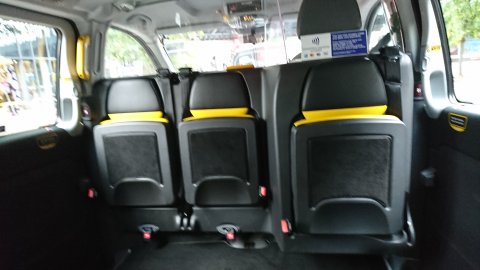リスク対応策 2020.02.14
RM 10 リスクに鋭敏な感性(プリズム)
For those who prefer to read this column in English, the Japanese text is followed by a British English translation, so please scroll down to the bottom of the Japanese text.
「内側半月板障害、外側側副靭帯断裂、前十字靭帯損傷」と、受け取った「診断書」には記されていた。生まれて初めてMRIのお世話になった結果である。

1.フル・マラソンへの挑戦
年齢を経て初めてのフル・マラソンへの挑戦。学生時代よりジョギングを続けていたとはいえ、「フル・マラソンとなると準備を整えなければ」と12月の「那覇マラソン」を目指して距離を5キロから10キロに伸ばした。元日からお屠蘇もほどほどに「走り初め」。国内でも海外でも出張時にはジョギングシューズを持参する。「ジョギング漬け」の毎日が続いていた。
「元陸上部員」の経験から運動後の柔軟体操は、入念におこなう。筋肉疲れを解すため。毎日10キロのジョギングを続けるために。週1回、15キロの走り込みを開始。1時間を優に越えていたそのタイムが徐々に縮まり1時間の壁が見えてきた。「今日はどうかな、おっ59分13秒、やった!」、柔軟体操を始めようとしたらなぜか左膝が「グニャッ」と曲がる。「どうしたのかな」、でも歩ける。多少の腫れを感じて湿布薬を貼った。
「その時既に傷害は起きていましたね、鍛えていたから他の筋肉がカバーしていたのでしょう」との医者の言葉。3日後、膝に激痛が走った。歓送迎会を終え駅に急いだとき。学生時代の経験から「あ、やった」と。ただ、まだ「単なる肉離れぐらい」と考えていた。
翌日の診断では「1週間ですね、まあ2週間はジョギング我慢してください」、しかし1週間経っても膝の腫れが収まらない。生まれて初めて「MRI」のお世話になった。その結果が冒頭の診断であった。「冷やすだけ」が唯一の治療法。自由に歩けない。四六時中松葉杖に頼る生活。「たった10センチの段差が上がれない」、「まさか滑らないだろう」と思っていた松葉杖が滑ることも判った。「手摺りの有難み」も嫌というほど感じた。大阪にはあった「地下鉄の駅から地上へのエレベーター」が東京では少ないことにも気がついた。
「以前なら2ヶ月の入院ですね。ギブスを作りますか、でもそれでは普通の生活が難しいでしょう」と膝をカバーする「コルセット装具」を作ることになった。「これは空港の金属探知機で鳴りますか?」、「もちろん、鳴ります」、真ん中から曲がるようになっている、「添え木」の役割を果たす、幅2センチ、長さ30センチほど先が食事用のナイフのように丸くカットされた厚い金属板を取り出して、「これだけありますからね」と見せてくれた。「そうだな」とロンドンの空港では「小さな鋏でも鳴った出来事」を思い出した。
2.空港の手荷物検査場
「これは外しますか」空港の係員に車椅子からそう尋ねると、「いえ結構です」と。「どうせ鳴るからかな」とそのまま通るが、鳴らない。「え?まさか」。でも帰りのロンドンの空港では鳴るはず。しかし「鳴るだろう」という眼で見ている係員を尻目に全く鳴らなかった。「え!なぜ鳴らない、何検査している。飛行機のフォークやナイフをプラスティックに変えたけど、それより大きい金属板だよ、大丈夫かな」と強い疑問が残った。
二つのことを学んだ。一つは「目線の違い」による「リスクの違い」である。健常者にとっては「10センチ程の段差」など「リスク」ではない。越えることなど訳はない。しかし「2本の松葉杖をついてその段差を超える」には自分でも「まさか」と思うぐらいの勇気が要った。雨の中松葉杖をつきながら歩くとき「磨かれた敷石」の上では杖の先にゴムキャップがあるのにいとも簡単に滑る。「滑るのですが、松葉杖の滑り止めはないですか」と装具の専門店に聞いたが「作っていない」とのこと。
「本当に商品やサービスを受ける側、使う側の目線」で作られているのだろうか、「お客様の意見や意向は大切にします」と言うが、「自分たちが使ったことがあるのだろうか、サービスを受けたことがあるのだろうか、松葉杖に限らず普通の商品でも同じことが言えるのではないだろうか」と。
3.ロンドン・タクシー
もう一つが、頻繁にロンドンに出張してきたが、いままで何百回「ロンドン・タクシー」に乗っても「見えなかったもの」が今回のケガによって初めて見えた。
日本のタクシーは、車椅子ではそのまま乗り込むことはできない、一旦車椅子をたたんで乗らなればならない。今年の東京オリンピックを前に、「外国人観光客を主たる対象に」したロンドン・タクシーが東京にも登場と、TV等のメディアでも紹介されている。「馬車」のスタイルを踏襲する、このロンドン・タクシーは運転席と客席を壁で完全に仕切る構造になっている。
その壁にある補助席を倒すと対面式に、普通車では5名、バンタイプでは最大6名が乗ることができる。ただ、運転席に比べて助手席が少し狭い。実は、助手席の後ろの壁に「車椅子を固定する装置」が付いていたのである。すべてのロンドン・タクシーは、車椅子でそのまま乗り込めるようになっていたのである。米国でもフランスでも他の国では見たことがない。「お客様を見る目線の違い」を感じた。

(バンタイプのロンドン・タクシー)
もう一つは「機械を再検証しないリスク管理」である。カルロス・ゴーン被告の逃亡劇などで、このところ航空会社、空港のリスク管理に関するトラブルが相次いでいる。
「鳴らなかったから、通っていい」となったが、誰の眼にも金属板があるのは明らかだった。身体にピタリとくっついていたからか、先が丸いからか、「もちろん、鳴ります」と言われたものが鳴らなかった。「金属探知機の測定基準」も検証されなければならないが、「なぜキラリと光る金属板があるのに『鳴らなかった』というだけで、止めもせず検査もしなかったのか」こちらの方が問題ではないだろうか。「空港のトラブル」のように「機械が正常反応だった」というリスク管理の問題点はないだろうか。
4.ソリューション・キャプティブ®
こういった目線に立つことを求めるリスクマネジメントが「グローバル・リンクの考えるリスクマネジメント」である。本来リスクマネジメントもそういう形で発展してきたが、「一方的な目線でリスクを見ている」と言われるようになってきた反省から、「サービスの提供者」も「サービスの受益者」も、そして地域、環境にも、幅広く目線を落としてリスクを検証する、そして全関係者のためになるリスクマネジメントが求められるようになってきた。
その進化した姿がソリューション・キャプティブ®として結実、多くの企業、団体の地震リスク、サイバーリスク等種々のリスクへの対応を通して、「キャプティブ設立のメリットを極大化するキャプティブ」として好評を得ているのである。
今回のまとめ
光そのものには色がない。「プリズム」はそれを7つの色に分ける。リスクマネジメントをおこなうには「このプリズムの役割を果たす感性豊かな人間の眼が必要」だと考える。
本物のリスクマネジメントの専門家からしか、本物のリスクマネジメントの指導を受けることはできない。ましてその結実であるキャプティブの設立に至っては、本当のプロフェッショナルと一緒に進めていかなければ不測の事態を招く恐れがある、キャプティブは究極のリスクマネジメント手段である、プロ中のプロと進めて行かれることをお勧めしたい。
その背景として、グローバル・リンクには、「そうしなかったことによって多くの課題を抱えた企業」から、「キャプティブからの再保険手配」に関して「全く手配されていなかったが、『それでいいですから』と聞いていたが、全くそうではなかった」というご相談を多く受けているからである。
執筆・翻訳者:羽谷 信一郎
English Translation
Risk Management 10 – A Sensitive Sensibility to Risk (Prism)
“Medial meniscus failure, torn lateral collateral ligament, anterior cruciate ligament injury,” the “medical certificate” I received said. This was the first time in my life that I had been under the care of an MRI.
1. The challenge of running a full marathon
This was my first attempt at a full marathon as a person of my age. Although I’ve been jogging since my school days, I knew I had to be ready for a full marathon, so I increased the distance from 5km to 10km, aiming to run the Naha Marathon、Okinawa in December. I started “First running” on New Year’s Day without drinking. When I went on business trips, both in Japan and abroad, I brought my jogging shoes with me, and my days were filled with jogging.
As a former track and field club member, I do calisthenics after exercise. This is to relieve muscle fatigue. To keep up the 10-kilometer jogging routine. I started running 15 kilometers once a week, and my time, which used to be over an hour, gradually shrank to less than an hour. “I don’t know about today, whoa, 59 minutes and 13 seconds, yay!” When I tried to do flexibility exercises, my left knee bent over for some reason. I wondered what was wrong, but I could walk. I felt some swelling and put a poultice on it.
The doctor said later, “The injury was already happening then, I guess the other muscles were covering it because you were working out.”Three days later, my knee started to ache. After the farewell party, I was rushing to the station. After my school experience, I said, “Oh, I did i”t. But I still thought it was “just a separation of the flesh”.
The next day, the diagnosis was, “One week, well, please endure jogging for two weeks,” but the swelling in my knee had not subsided even after a week. And for the first time in my life, I had an MRI scan. The result was the diagnosis described at the beginning of this article. “Just cool it down” was the only treatment. I cannot walk freely. I depended on crutches all the time. I found out that I couldn’t climb up a 10cm step and that my crutches slipped when I thought they wouldn’t slip. I also felt the gratitude of the handrail. I also noticed that in Tokyo, there were fewer elevators from subway stations to the ground than there were in Osaka.
“Before, you were in the hospital for two months. I could make you a cast, but that would make it difficult for you to live a normal life.” “A corset brace” to cover your knee. ‘Will this go off at the metal detector at the airport?’ He took out a thick sheet of metal that bends out of the middle and acts as a braces, two centimeters wide and thirty centimeters long, cut round at the end like a meal knife, and showed it to me, “Of course it rings,” he said, “because this is all there is to it. “Yes,” I said, recalling the incident at the London airport where “even the little shears rang.”
2. The baggage checkpoint at the airport
I asked the airport attendant from my wheelchair, “Do you want this off?””No, thank you. “I walked straight through, “Because it’s going to ring anyway,” but it didn’t. “Huh? No way. “But it should have rung on the way back to London airport. But it didn’t ring at all, as the attendants looked at me like “it will ring. “I thought, “What! Why doesn’t it ring, what are you inspecting? I was left with strong doubts, “I’ve changed the forks and knives on the plane to plastic, but it’s a bigger metal plate than that, is it okay?”
I learned two things. The first is the “risk difference” between the two “eye lines”. For an able-bodied person, a step of about 10 cm is not a risk. There is no reason for them to cross it. But to “climb over the step with two crutches”, it took a lot of courage, even to think “no way”. When I walked with my crutches in the rain on the “polished paving stone”, the crutches slipped easily even though there was a rubber cap on the end of the crutches. I asked the orthotics shop if they had any non-slip crutches, but they said they didn’t make them.
I wonder if they are really made from “the point of view of the recipient or user of the product or service”, they say that they value the opinions and intentions of their customers, but I wonder if they have used them or received the service, and I wonder if the same can be said for ordinary products, not just crutches.
3. London Taxi.
Another thing that I hadn’t been able to see no matter how many hundreds of times I had taken London taxis, was visible for the first time because of my injury.
In Japan, you can’t get into a taxi with a wheelchair, you have to fold the wheelchair before getting in. Ahead of the Tokyo Olympics this year, TV and other media have reported that London taxis will be coming to Tokyo to “mainly target foreign tourists”. Following the style of a horse-drawn carriage, these London taxis have a wall that completely separates the driver’s seat from the passenger seat.
An auxiliary seat on the wall can be folded down to allow five passengers in a standard car or up to six in a van. However, compared to the driver’s seat, the passenger seat is a bit narrower. In fact, there was a “wheelchair securing device” on the wall behind the passenger seat. All London taxis were wheelchair-accessible. I’ve never seen this in any other country, not in the U.S., not in France, not in any other country. I felt a difference in the way of looking at the customers.
The other is “risk management that does not re-examine the machine”. With the escape of Carlos Ghosn and others, there has been a recent spate of problems with risk management at airlines and airports.
“It didn’t ring, so I was allowed to go through,” but it was clear to everyone’s eyes that there was a metal plate.Perhaps it was because it was snugly attached to the body, or perhaps it had a round tip, or perhaps it was because the metal plate didn’t ring when we were told, “Of course it will ring,” but it didn’t. Maybe it was because it was snugly attached to the body, or maybe it was because the tip was round, but what we were told was “of course it will ring” didn’t ring. The “standard of measurement for metal detectors” needs to be examined, but I think this one is more problematic: “Why didn’t they stop and inspect the shiny metal plate that was there and say ‘it didn’t ring’? Isn’t this more of a risk management issue, like the “trouble at the airport” where the machine was responding normally?
“It didn’t ring, so you can go through,” but it was obvious to everyone’s eyes that there was a metal plate. Maybe it was because it was snugly attached to the body, or maybe it was because it had a round tip, but what I was told “of course, it will ring” did not ring.
The “standard of measurement for metal detectors” needs to be examined, but I think this one is more problematic: “Why didn’t they stop and inspect the shiny metal plate that was there and say ‘it didn’t ring’? “Isn’t there a risk management issue with “the machine was reacting normally” as in “airport trouble?”
4. Solution Captive®.
Global Link’s approach to risk management is one that requires companies to take this kind of standpoint. However, after reflecting on the fact that it has come to be said that risk is viewed from a one-sided perspective, we have developed a risk management approach that examines risks from the perspective of both service providers and beneficiaries of services, as well as local communities and the environment, and that is beneficial to all parties involved. Management has come to be required.
This evolution has resulted in the Solution Captive®, which has been well received by many companies and organizations as a captive that maximizes the benefits of establishing a captive through its response to various risks such as earthquake risk and cyber risk.
Summary of this issue
Light itself has no color. A prism divides it into seven colors. In order to conduct risk management, we believe that we need a sensitive human eye to fulfill the role of this prism.
Only a real risk management expert can provide guidance on real risk management. When it comes to the establishment of a captive, which is the fruit of risk management, as a captive is the ultimate risk management tool, and I recommend that you work with the best of the professionals, because if you don’t work with real professionals, you may have unforeseen problems.
We have heard from dozens companies that they have had to deal with a lot of problems because they did not do so, and that they were told “that’s fine” but that wasn’t the case at all, in relation to reinsurance arrangements from captives.
Author/translator: Shinichiro Hatani

